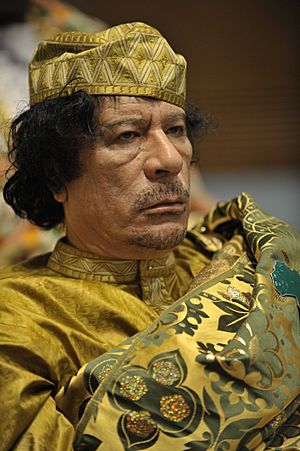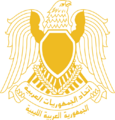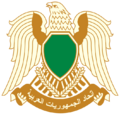History of Libya under Muammar Gaddafi facts for kids
Muammar Gaddafi became the leader of Libya on September 1, 1969. He led a group of young army officers in a peaceful takeover against King Idris I. After the king left the country, Gaddafi's group, called the Revolutionary Command Council (RCC), ended the monarchy. They created the Libyan Arab Republic, with the goal of "freedom, socialism and unity."
Libya's name changed a few times while Gaddafi was in charge. From 1969 to 1977, it was the Libyan Arab Republic. In 1977, it became the Socialist People's Libyan Arab Jamahiriya. Gaddafi created the word Jamahiriya, which means "state of the masses." In 1986, after the United States bombed Libya, the country was renamed the Great Socialist People's Libyan Arab Jamahiriya.
After taking power, Gaddafi's government focused on providing education, healthcare, and housing for everyone. Education became free, and primary school was required for all children. Medical care was also free. Libya's income per person grew a lot, making it one of the richest countries in Africa. However, Gaddafi's government also had a foreign policy that caused arguments and limited people's freedoms at home.
During the 1980s and 1990s, Gaddafi supported rebel groups around the world. These included Nelson Mandela's African National Congress and Yasser Arafat's Palestine Liberation Organization. Libya was also involved in wars with neighboring countries in Africa, like Chad. These actions made many Western countries unhappy with Libya. Gaddafi said he was helping groups that fought against powerful countries and supported civil rights movements. After the 9/11 attacks in 2001, Libya improved its relationships with NATO countries. Sanctions (penalties) against Libya were lifted when the country agreed to stop its nuclear weapons program.
In early 2011, a civil war started in Libya. This was part of a bigger movement called the Arab Spring. Rebel groups formed the National Transitional Council to lead areas they controlled. After fighting and killings by both sides, a group of countries led by NATO stepped in to support the rebels in March 2011. Gaddafi's government was overthrown when the rebels took over Tripoli in August. Fighting continued in Gaddafi's hometown of Sirte. On October 20, 2011, Sirte fell, and Gaddafi was killed. This marked the end of the Libyan Arab Jamahiriya.
Contents
- Libyan Arab Republic (1969–1977)
- Great Socialist People's Libyan Arab Jamahiriya (1977–2011)
- Egyptian–Libyan War
- International Relations
- Opposition and Challenges to Gaddafi's Rule
- Flags and Symbols (1969–2011)
- See also
Libyan Arab Republic (1969–1977)
Quick facts for kids
Libyan Arab Republic
|
|||||||||
|---|---|---|---|---|---|---|---|---|---|
| 1969–1977 | |||||||||
|
|
|||||||||
|
Anthem: وَاللَّهُ زَمَانْ يَا سِلَاحِي
Walla Zaman Ya Selahy "It has been a long time, oh my weapon!" ٱللَّٰهُ أَكْبَرُ Allāhu Akbar "God is the Greatest" |
|||||||||

Location of Libyan Arab Republic
|
|||||||||
| Capital | Tripoli | ||||||||
| Common languages | |||||||||
| Government | Unitary Nasserist one-party Arab socialist republic under a military dictatorship | ||||||||
| Chairman of the Revolutionary Command Council (head of state) |
|||||||||
|
• 1969–1977
|
Muammar Gaddafi | ||||||||
| Prime Minister | |||||||||
|
• 1969–1970 (first)
|
Mahmud Suleiman Maghribi | ||||||||
|
• 1972–1977 (last)
|
Abdessalam Jalloud | ||||||||
| Historical era | Cold War and Arab Cold War | ||||||||
|
• Coup d'état
|
1 September 1969 | ||||||||
|
• Jamahiriya established
|
2 March 1977 | ||||||||
| Population | |||||||||
|
• 1977
|
2,681,900 | ||||||||
| Currency | Libyan dinar (LYD) | ||||||||
| Calling code | 218 | ||||||||
| ISO 3166 code | LY | ||||||||
|
|||||||||
| Today part of | Libya | ||||||||
The 1969 Takeover
Libya became a rich country after finding a lot of oil reserves in 1959. However, many people were unhappy that King Idris and his family kept most of this wealth. This feeling grew stronger with new ideas about Arab unity and socialism spreading in the region.
On September 1, 1969, about 70 young army officers, called the Free Officers Movement, took control of the government. They ended the monarchy without any violence. The takeover started in Benghazi and was finished in just two hours. Army units quickly supported the change, and military control was set up across the country. Many young people in cities were excited about the takeover. There were no reports of deaths or violence.
The Free Officers Movement, led by a twelve-member group called the Revolutionary Command Council (RCC), became the new government. On September 1, the RCC announced that Libya was now a free country called the Libyan Arab Republic. They promised "freedom, unity, and social justice" for all citizens. They said the old government was from "dark ages" and called on Libyans to move to a new time of wealth and equality.
The RCC told other countries that the changes were not from outside Libya. They promised to keep existing agreements and protect foreign people and property. Many countries quickly recognized the new government, including the United States on September 6.
After the Takeover
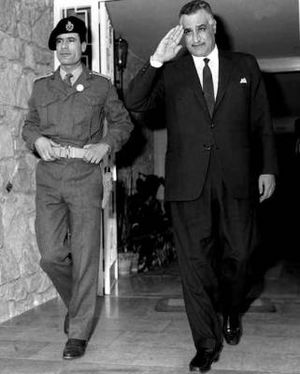
The new government worried that King Idris or his heir, Crown Prince Hasan as-Senussi, might try to fight back. However, Hasan, who was arrested during the takeover, publicly gave up his claim to the throne. He supported the new government and asked people to accept it peacefully.
King Idris, who was in Egypt, also said he would not try to return to Libya. In return, the RCC promised his family in Libya would be safe. Idris stayed in Egypt until he died in 1983.
On September 7, 1969, the RCC named a new cabinet to run the country. Mahmud Suleiman Maghribi, an engineer who had been in prison for his political actions, became the prime minister. He led eight ministers, six of whom were civilians and two were military officers. The RCC made it clear that they held the main power. The next day, Captain Gaddafi was promoted to colonel and became the commander of the Libyan Armed Forces. By January 1970, it was clear that Gaddafi was the main leader of Libya.
Many people noticed that Libya's takeover was very similar to Egypt's in 1952, led by Gamal Abdel Nasser. It seemed Nasser's ideas were a model for the Free Officers Movement. The RCC quickly started making changes in Libya. They announced that Libya would be neutral in the Cold War and against all forms of colonialism. They also supported Arab unity and the Palestinian cause against Israel.
The RCC confirmed that Libya was part of the "Arab nation" and that Islam was its state religion. They ended the parliament and banned political parties. The new government rejected communism because it was atheist. Instead, they supported an Arab version of socialism that combined Islamic ideas with social, economic, and political changes. Libya quickly moved from being a traditional Arab state to a more radical one.
Stopping Challenges to Power
After forming the Libyan Arab Republic, Gaddafi and his group said their government would not be led by one person. However, this changed over time.
The first big change in the government happened in December 1969. The defense minister, Adam Said Hawwaz, and the interior minister, Musa Ahmad, were arrested. They were accused of planning a takeover. In the new government formed after this, Gaddafi became prime minister and defense minister, while still leading the RCC.
Major Abdel Salam Jallud, who was seen as second in command to Gaddafi in the RCC, became deputy prime minister. The government faced another challenge in July 1970. Abdullah Abid Sanusi and Ahmed al-Senussi, who were distant relatives of the former King Idris, were accused of trying to take power. After this plot was stopped, more changes were made to the government. For the first time, officers from the RCC became the majority of the new ministers.
Gaddafi Takes More Control
From the beginning, the RCC wanted to hold the old government accountable. In 1971 and 1972, over 200 former government officials, including prime ministers and royal family members, were put on trial for treason and corruption. Many, like King Idris, were tried while they were living outside Libya. Some were found guilty and given prison sentences or fines. Five people were sentenced to death, though most were not present for their trials.
Gaddafi also ended the Senussi order, a religious group that had played a big role in Libya's independence. He said that regional and tribal issues were stopping social progress and Arab unity. He removed traditional leaders and changed administrative borders to break up tribal groups.
The Free Officers Movement was renamed the "Arab Socialist Union" (ASU) in 1971. It became the only legal political party in Libya. It was meant to help Libyans become more politically aware and help the RCC make public policy. Trade unions became part of the ASU, and strikes were banned. The press was also controlled by the government. In October 1970, Italians and the remaining Jewish community were forced to leave the country, and their property was taken.
In 1972, Libya joined the Federation of Arab Republics with Egypt and Syria. This plan for a united Arab state never fully happened.
As time went on, Gaddafi became more focused on international issues than on running Libya. He had strong ideas about Arab unity and Islam fighting against what he called "evil forces." Because of this, Major Jallud took over many of Gaddafi's daily administrative tasks, becoming prime minister in 1972. Two years later, Jallud took on even more duties so Gaddafi could focus on his political ideas. Gaddafi remained the commander of the armed forces and the real head of state.
Becoming Closer to the Soviet Union
After the 1969 takeover, U.S. forces continued their planned exit from Wheelus Air Base, as agreed with the previous government. The last American soldiers left on June 11, 1970, which became a national holiday in Libya. British bases were also closed in March 1970.
As relations with the U.S. got worse, Gaddafi built strong ties with the Soviet Union and other Eastern European countries. However, Libya still said it was a non-aligned country and was against the spread of communism in the Arab world. Libya's army grew much larger and was equipped with Soviet weapons.
Oil and Politics
Libya's economy was based on its oil money. Libya had less oil than other big Arab oil countries. Because of this, Libya was more willing to limit oil production to save its natural wealth. It also pushed harder for higher oil prices. Oil was seen as a way to pay for Libya's development and as a political tool against Israel.
After the 1969 takeover, oil production increased, and Libya demanded higher oil prices and more control over its oil industry. Foreign oil companies agreed to raise prices significantly in early 1971. In December, Libya took over the oil company British Petroleum in Libya and pulled its money from British banks because of a foreign policy disagreement.
In 1973, the Libyan government took control of most other oil companies in the country. By early 1974, Libya controlled about 60% of its oil production, which later rose to 70%. Libya still needed foreign experts and money for oil exploration and production.
The 1973 Oil Crisis
Libya strongly pushed the Organization of Petroleum Exporting Countries (OPEC) to use oil as a weapon against Israel and its supporters. Libya's strong stance helped lead to OPEC's actions in 1973 to raise oil prices and stop oil sales. On October 19, 1973, Libya was the first Arab nation to stop selling oil to the United States. This happened after the U.S. announced military aid to Israel during the Yom Kippur War. Other Arab oil-producing nations followed Libya's lead.
While other Arab nations lifted their oil bans in March 1974, Gaddafi's government refused. As a result, Libya's oil production dropped by half between 1970 and 1974, but its income from oil exports more than quadrupled. Production continued to fall until 1975. After that, it stayed around two million barrels per day. Production and income fell again in the early 1980s because Libyan oil was expensive and there was less demand for oil worldwide.
Libya's Five-Year Economic and Social Transformation Plan (1976–80), announced in 1975, planned to invest $20 billion in many economic activities. The goal was to create income for Libya after its oil ran out. Agriculture received the most money to make Libya self-sufficient in food. Industry also received a lot of funding in the first and second development plans.
Moving Towards the Jamahiriya (1973–1977)
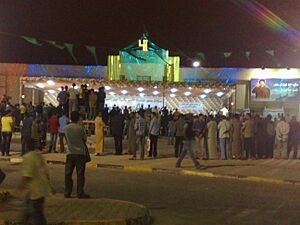
Gaddafi's ideas for "remaking Libyan society" began to be put into action in 1973 with a "cultural revolution." This revolution aimed to make the government more efficient and get more people involved in local government. Gaddafi encouraged Libyans to challenge old authorities and take control of government bodies themselves. They did this through "people's committees."
Within a few months, over 2,000 people's committees were set up across Libya. These committees were based on different jobs and locations. They became responsible for local and regional administration. Committees were formed in universities, businesses, government offices, and media. Local committees were chosen by direct public vote. The idea was that these committees would show the "direct democracy" that Gaddafi wrote about in The Green Book in 1976. This idea also led to the creation of "people's congresses," with the main one being the General People's Congress (GPC), which was meant to replace the RCC.
1976 Student Protests
During this time of change, on April 7, 1976, university students in Tripoli and Benghazi protested. They spoke out against human rights problems and the military's control over Libya. The students asked for fair elections and a civilian government. Violent counter-protests happened, and many students were put in prison. On April 7, 1977, the anniversary of the protests, students were publicly executed in Benghazi. Military officers who opposed Gaddafi were also executed later that week. Friends of those executed were forced to watch. Public executions continued every April 7 until the late 1980s.
Great Socialist People's Libyan Arab Jamahiriya (1977–2011)
|
Socialist People's Libyan Arab Jamahiriya
(1977–1986) اَلْجَمَاهِيْرِيَّة ٱلْعَرَبِيَّة ٱللِّيْبِيَّة ٱلشَّعْبِيَّة ٱلْإِشْتِرَاكِيَّة (Arabic) al-Jamāhīrīyya al-'Arabīyya al-Lībīyya al-Sha'bīyya al-Ishtirākīyya Great Socialist People's Libyan Arab Jamahiriya (1986–2011) اَلْجَمَاهِيْرِيَّة ٱلْعَرَبِيَّة ٱللِّيْبِيَّة ٱلشَّعْبِيَّة ٱلْإِشْتِرَاكِيَّة ٱلْعُظْمٰى (Arabic) al-Jamāhīrīyya al-'Arabīyya al-Lībīyya al-Sha'bīyya al-Ishtirākīyya al-'Uẓmá |
|||||||||
|---|---|---|---|---|---|---|---|---|---|
| 1977–2011 | |||||||||
|
|
|||||||||
|
Motto: وَحْدَةٌ، حُرِّيَّةٌ، اِشْتِرَاكِيَّةٌ
Waḥda, Ḥurriyya, Ishtirākiyya "Unity, Freedom, Socialism" |
|||||||||
|
Anthem: ٱللَّٰهُ أَكْبَرُ
Allāhu Akbar "God is the Greatest" |
|||||||||
 |
|||||||||
| Capital | Tripoli (1977–2011) Sirte (2011) 32°52′N 13°11′E / 32.867°N 13.183°E |
||||||||
| Largest city | Tripoli | ||||||||
| Official languages | Arabic | ||||||||
| Spoken languages | |||||||||
| Minority Languages |
|
||||||||
| Ethnic groups |
|
||||||||
| Religion | Islam | ||||||||
| Government | Unitary Islamic socialist Jamahiriya under an authoritarian regime | ||||||||
| Brotherly Leader and Guide of the Revolution |
|||||||||
|
• 1977–2011
|
Muammar Gaddafi | ||||||||
| Secretary-General of the General People's Congress (head of state and head of legislature) | |||||||||
|
• 1977–1979 (first)
|
Muammar Gaddafi | ||||||||
|
• 2010–2011 (last)
|
Mohamed Abu al-Qasim al-Zwai | ||||||||
| Secretary-General of the General People's Committee (head of government) | |||||||||
|
• 1977–1979 (first)
|
Abdul Ati al-Obeidi | ||||||||
|
• 2006–2011 (last)
|
Baghdadi Mahmudi | ||||||||
| Legislature | General People's Congress | ||||||||
| Historical era | Cold War · War on Terror · Arab Spring | ||||||||
|
• People's Authority
|
2 March 1977 | ||||||||
| 15 February 2011 | |||||||||
|
• Fall of Tripoli
|
28 August 2011 | ||||||||
|
• Gaddafi killed
|
20 October 2011 | ||||||||
| Area | |||||||||
|
• Total
|
1,759,541 km2 (679,363 sq mi) (16th) | ||||||||
| Population | |||||||||
|
• 2010
|
6,355,100 | ||||||||
| GDP (nominal) | 2007 estimate | ||||||||
|
• Total
|
|||||||||
|
• Per capita
|
|||||||||
| HDI (2009) | high |
||||||||
| Currency | Libyan dinar (LYD) | ||||||||
| Calling code | 218 | ||||||||
| ISO 3166 code | LY | ||||||||
|
|||||||||
On March 2, 1977, the General People's Congress (GPC) officially created the Socialist People's Libyan Arab Jamahiriya. Gaddafi said this "Jamahiriya" system was special to Libya. It was meant to be a way for the people to rule directly. The GPC also created the General Secretariat, with Gaddafi as its head. A new General People's Committee replaced the old Council of Ministers.
The Libyan government said the Jamahiriya was a direct democracy with no political parties. It was supposedly run by the people through local councils. Official statements said that the idea of a "nation state" was not important. Instead, family and tribal connections remained very strong, even in the army.
What "Jamahiriya" Means
Jamahiriya is an Arabic word that means "state of the masses." It was a term Gaddafi created. It's similar to the idea of a "People's Republic." The word comes from the Arabic word for "republic" by changing it to its plural form, meaning "the masses." It is often left untranslated in English, so the country's full name was "Great Socialist People's Libyan Arab Jamahiriya."
After the 1986 U.S. bombing, Gaddafi added the word "Great" to the country's official name.
Changes in Government and Economy (1977–1980)
Gaddafi as "Brotherly Leader"
In March 1979, the General People's Congress announced that "power was now with the masses." Gaddafi gave up his official role as general secretary of the GPC. However, he remained the "Leader of the Revolution" and kept control of the government and the country. He also stayed the supreme commander of the armed forces.
Government Changes
All law-making and executive power was given to the GPC. But the GPC gave most of its important power to its general secretary and the General People's Committee. Gaddafi remained the main decision-maker. All adults were supposed to take part in their local Basic People's Congress (BPC) meetings. Decisions from these local groups were then sent to the GPC to become national policy. In theory, the BPCs held the most political power, showing Gaddafi's idea of "people's power."
To continue changing Libya's government, Gaddafi introduced "revolutionary committees" in 1977. These committees were supposed to guide the people's committees and increase people's dedication to revolutionary ideas. In reality, these committees watched the population and stopped any political opposition to Gaddafi's rule. It is believed that 10% to 20% of Libyans worked as informants for these committees.
These revolutionary committees, made up of strong supporters of Gaddafi, took control of BPC elections in 1979. Even though they were not official government bodies, they became very important in Libyan politics. By the late 1970s, the government system became very complicated, with many groups having overlapping responsibilities. This confusion might have helped Gaddafi stay in charge while appearing less visible.
The Revolutionary Command Council (RCC) was officially ended. The government was reorganized into people's committees. A new General People's Committee (cabinet) was chosen. Gaddafi also wanted to create a "people's army" by replacing the national army with a national militia. This idea came up again in 1982 but was not fully put into action.
Gaddafi also wanted to fight against strict social rules for women. He created the Revolutionary Women's Formation to encourage changes. In 1970, a law was passed saying men and women were equal and should be paid the same. In 1971, Gaddafi supported the creation of a Libyan General Women's Federation. In 1972, a law was passed making it illegal for girls under 16 to marry. It also made sure a woman's agreement was needed for a marriage.
Economic Changes
Changes to the economy happened alongside changes to politics and society. Until the late 1970s, Libya had a mixed economy. Private businesses played a big role, except in oil, banking, and insurance. But Gaddafi's Green Book said that private retail trade, rent, and wages were wrong and should be ended. Instead, workers' committees and profit-sharing groups were supposed to run businesses.
A law was passed that said people could not own more than one home. Libyan workers took control of many companies, turning them into state-run businesses. State-owned "people's supermarkets" replaced private shops, where Libyans could supposedly buy what they needed at low prices. By 1981, the government also limited access to private bank accounts to use private money for government projects. These changes made many people angry, especially those who lost their property. Many educated Libyans left the country, which was a big loss for Libya.
The government also built a large water pipeline across the Sahara Desert. This project, called the Great Manmade River, started in 1984. It brings huge amounts of water from underground to cities and new farming areas.
Libya still needed skilled workers from other countries and imported many consumer goods, all paid for with oil money. Libya consistently had the highest Human Development Index (HDI) in Africa, meaning its people had a high quality of life. Gender equality was a major achievement under Gaddafi. More women attended university and had more job opportunities than in most Arab nations.
Military Actions
Wars with Chad and Egypt
As early as 1969, Gaddafi started a campaign against Chad. Libya was also involved in a border dispute with Chad over the Aouzou Strip, which Libya took over in 1973. This led to the Libyan invasion of Chad. Libyan troops were finally pushed out in 1987, after Chad received help from the U.S. and France. This conflict ended with a ceasefire in 1987. After a court decision in 1994, Libya withdrew its troops, and the dispute was settled. Many Libyans were against this war because thousands of high school students were forced to fight.
In 1977, Gaddafi sent his military into Egypt, but Egyptian forces fought back in the Egyptian–Libyan War. Both countries agreed to a ceasefire with help from the President of Algeria.
The Islamic Legion
In 1972, Gaddafi created the Islamic Legion. This group was meant to help unite and Arabize the region. Its main goals were in Chad and Sudan. The Islamic Legion was mostly made up of immigrants from poorer African countries. Many of its members had come to Libya hoping for civilian jobs but were forced to join the military. A French journalist said they were "mercenaries against their will, poor people who came to Libya hoping for a civilian job, but found themselves forced to go and fight in an unknown desert."
The Islamic Legion's actions in Chad led to cross-border raids that caused a separate conflict in Darfur, Sudan. This conflict killed about 9,000 people between 1985 and 1988. The Janjaweed, a group accused of genocide in Darfur in the 2000s, emerged in 1988, and some of its leaders were former legionnaires.
Nuclear and Chemical Weapons Attempts
In 1972, Gaddafi tried to buy a nuclear bomb from China. He then tried to get one from Pakistan, but Pakistan stopped its program. In 1978, Gaddafi asked India for help building a nuclear bomb. Libya and India signed an agreement to work together on peaceful uses of nuclear energy. In 1991, Pakistan's Prime Minister, Navaz Sharif, visited Libya. Gaddafi surprised him by demanding that Pakistan sell him a nuclear weapon. When Sharif refused, Gaddafi insulted him. Sharif canceled the talks and sent the Libyan ambassador out of Pakistan.
Thailand reported that its citizens helped build storage places for nerve gas in Libya. Germany sentenced a businessman to prison for his involvement in Libyan chemical weapons. In 2004, inspectors confirmed that Libya had a stockpile of 23 metric tons of mustard gas and over 1,300 metric tons of chemicals used to make it.
Conflicts with the U.S.
On August 19, 1981, U.S. F-14 fighter jets shot down two Libyan fighter jets over the Gulf of Sirte in the Mediterranean Sea. This happened because Libya claimed the area as its territory. A second similar event occurred on January 4, 1989, when U.S. jets shot down two more Libyan planes in the same area.
On March 23, 1986, U.S. naval forces attacked Libyan naval forces and missile sites. U.S. jets destroyed missile launchers and sank several ships, killing 35 sailors. This was a response to terrorist hijackings that had happened between June and December 1985.
On April 5, 1986, Libyan agents bombed the "La Belle" nightclub in West Berlin, killing three people and injuring 229. Gaddafi's plan was found out by intelligence agencies. The Libyan agents involved were later prosecuted in Germany.
In response to the nightclub bombing, the U.S. Air Force, Navy, and Marine Corps launched air strikes against Libya on April 15, 1986. This operation was called "Operation El Dorado Canyon." Air defenses, army bases, and airfields in Tripoli and Benghazi were bombed. The attacks did not kill Gaddafi, but he lost several military officers.
After the 1986 bombing, Gaddafi increased his support for anti-American groups. He financed a gang in Chicago to plan attacks on U.S. government buildings. In 1986, Libyan state television announced that Libya was training groups to attack American and European targets. Gaddafi also started funding the Irish Republican Army (IRA) again to get back at the British for allowing American planes to use their bases.
Gaddafi announced that he had won a great military victory over the U.S. The country was officially renamed the "Great Socialist People's Libyan Arab Jamahiriyah." However, his speeches seemed less passionate, and celebrations were unusual. People in Libya became more open in their criticism of Gaddafi. The attacks had weakened his government to its lowest point in 17 years.
The 2011 Civil War and Fall of Gaddafi's Government
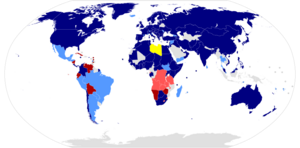
A new serious threat to the Libyan Arab Jamahiriya came in February 2011 with the 2011 Libyan revolution. This unrest was inspired by uprisings in Tunisia and Egypt, connecting it to the larger Arab Spring. In eastern Libya, the National Transitional Council was formed in Benghazi.
Many Libyan officials sided with the protesters and asked for international help to stop the killings of civilians. By the end of February, Gaddafi's government had lost control of half of Libya. However, Gaddafi still controlled some areas in September. On September 21, rebel forces captured Sabha, a major city, further reducing Gaddafi's control.
Many nations criticized Gaddafi's government for using force against civilians. Other nations allied with Gaddafi, saying the uprising was a "plot" by Western countries to take Libya's resources. The United Nations Security Council passed a resolution on March 17, 2011, to create a "no-fly zone" over Libya.
The UN resolution allowed air strikes against Libyan ground troops and warships that threatened civilians. On March 19, the no-fly zone began, with French aircraft flying missions over Libya and a naval blockade by the British Royal Navy. U.S. forces called their part of the action "Operation Odyssey Dawn." More than 110 cruise missiles were fired by U.S. warships and a British submarine against Libyan air defenses.
The last areas held by Gaddafi's forces in Sirte fell to anti-Gaddafi fighters on October 20, 2011. After Muammar Gaddafi's death, Libya was officially declared "liberated" on October 23, 2011. This ended Gaddafi's 42 years of leadership in Libya.
A political expert suggested in October 2011 that Gaddafi had created a "great void" in Libya. There were no strong institutions, no army, and no tradition of elections. Because of this, the time after Gaddafi would be very difficult for Libya.
Egyptian–Libyan War
On July 21, 1977, fighting broke out between Libyan and Egyptian troops on the border. Relations between the two countries had been getting worse since the end of the Yom Kippur War in October 1973. This was because Libya opposed Egyptian President Anwar Sadat's peace efforts and because talks to unite the two countries had failed.
There is some evidence that Egypt considered war against Libya as early as 1974. Egypt had also ended its military ties with Moscow, while Libya continued its cooperation. Egypt also helped former Libyan officials who tried to overthrow Gaddafi in 1975. In 1976, Egypt claimed to have found a Libyan plot to overthrow its government. On August 8, 1976, an explosion in Cairo injured 14 people, and Egypt blamed Libyan agents. Egypt also claimed to have arrested two Egyptians trained by Libyan intelligence to cause damage in Egypt. On August 23, an Egyptian passenger plane was hijacked by people reportedly working with Libyan intelligence. They were captured without injury. In response to Egypt's accusations, Libya closed the Egyptian Consulate in Benghazi. On July 24, 1977, both sides agreed to a ceasefire with help from the President of Algeria and the Palestine Liberation Organization Chairman.
International Relations
Africa
Gaddafi was a strong supporter of Ugandan President Idi Amin. He sent thousands of troops to fight for Idi Amin against Tanzania. About 600 Libyan soldiers died trying to defend Amin's government. After the fall of Kampala, Amin eventually left Uganda for Libya before settling in Saudi Arabia.
Gaddafi also helped Jean-Bédel Bokassa, the Emperor of the Central African Empire. He sent military help to the Central African Republic in 2001 to protect his ally. This ally signed a deal giving Libya a 99-year lease to use all of that country's natural resources, including uranium, copper, diamonds, and oil.
Gaddafi supported Ethiopia's leader, Mengistu Haile Mariam. He also supported rebel groups in Somalia that fought to overthrow the dictatorship there.
Gaddafi strongly opposed apartheid in South Africa and became friends with Nelson Mandela. One of Mandela's grandsons is named Gaddafi, showing the support Gaddafi had in South Africa. Gaddafi funded Mandela's 1994 election campaign. After becoming president, Mandela refused requests from U.S. President Bill Clinton to cut ties with Gaddafi. Mandela later helped Gaddafi gain acceptance in the Western world in the late 1990s. Over the years, Gaddafi was seen as a hero in much of Africa because of his revolutionary image.
Gaddafi was a strong supporter of Zimbabwean President Robert Mugabe.
Gaddafi's World Revolutionary Center (WRC) near Benghazi became a training center for groups he supported. Leaders who trained there include Blaise Compaoré of Burkina Faso and Idriss Déby of Chad.
Gaddafi trained and supported Liberian warlord-president Charles Taylor, who was later charged with war crimes. Foday Sankoh, who started the Revolutionary United Front, also trained with Gaddafi. This group was known for cutting off the arms and legs of people in Sierra Leone to take control of diamond fields. Gaddafi supported them with weapons.
Gaddafi's strong military and financial support gained him allies across Africa. He had himself crowned "King of Kings of Africa" in 2008. This happened in front of over 200 African traditional rulers and kings. However, his ideas for African political and military unity did not get much support from their governments. In 2009, he was elected head of the African Union. Gaddafi told African leaders: "I shall continue to insist that our sovereign countries work to achieve the United States of Africa."
Gaddafi and International Groups
In 1971, Gaddafi warned that if France opposed Libya's military actions in Chad, he would use all weapons, including "revolutionary weapons," against France. On June 11, 1972, Gaddafi announced that any Arab who wanted to join Palestinian groups could sign up at any Libyan embassy and would get combat training. He also promised money for attacks. On October 7, 1972, Gaddafi praised a massacre carried out by a communist group and asked Palestinian groups to do similar attacks.
Gaddafi was said to be a major funder of the "Black September Movement," which carried out the Munich massacre at the 1972 Summer Olympics. In 1973, Irish authorities stopped a ship carrying Soviet weapons from Libya to the Provisional Irish Republican Army (IRA). In 1976, after a series of attacks by the IRA, Gaddafi said that the bombs shaking Britain were from the Libyan people. He said they were sent to Irish revolutionaries so the British would pay for their past actions.
In the Philippines, Libya supported the Moro Islamic Liberation Front, which continues to use violence to create a separate Islamic state. Libya also supported the New People's Army. The Islamist group Abu Sayyaf is also suspected of receiving Libyan money.
Gaddafi also strongly supported the Palestine Liberation Organization. This support hurt Libya's relations with Egypt when Egypt made a peace agreement with Israel in 1979. As relations with Egypt worsened, Gaddafi sought closer ties with the Soviet Union. Libya was the first country outside the Soviet bloc to receive advanced fighter jets. Gaddafi also tried to increase Libya's influence in countries with Muslim populations by calling for a Saharan Islamic state and supporting anti-government forces in Africa.
In the 1970s and 1980s, Gaddafi often gave support freely, even to groups with very different ideas from his own. This often confused international opinion.
In October 1981, Egypt's President Anwar Sadat was killed. Gaddafi called it a "punishment."
In December 1981, the U.S. government made it illegal for U.S. citizens to travel to Libya. In March 1982, the U.S. banned the import of Libyan oil.
Gaddafi reportedly spent millions of dollars on training and arming Sandinistas in Nicaragua. The President of Nicaragua was his ally.
In April 1984, Libyan refugees in London protested against the execution of two people. British intelligence found out that Tripoli ordered its diplomats to use violence against the protesters. Libyan diplomats shot at 11 people and killed a British policewoman. This led to Britain and Libya ending their diplomatic relations for over ten years.
After the December 1985 attacks at airports in Rome and Vienna, which killed 19 people, Gaddafi said he would continue to support certain groups as long as European countries supported Libyans who opposed him. Libya's Foreign Minister called the attacks "heroic acts."
In 1986, Libyan state television announced that Libya was training suicide groups to attack American and European targets.
On April 5, 1986, Libyan agents were accused of bombing the "La Belle" nightclub in West Berlin, killing three people and injuring 229. Gaddafi's plan was found by Western intelligence. The Libyan agents who carried out the attack from the Libyan embassy in East Germany were later prosecuted in Germany.
In May 1987, Australia ended relations with Libya because of its role in causing violence in Oceania.
Under Gaddafi, Libya had a long history of supporting the Irish Republican Army during the conflict in Northern Ireland. In late 1987, French authorities stopped a ship carrying 150 tons of Libyan weapons to the IRA. Gaddafi gave the IRA over $12.5 million in cash and six large shipments of weapons.
Gaddafi supported several Islamist and communist groups in the Philippines, including the New People's Army and the Moro Islamic Liberation Front. In Indonesia, the Free Aceh Movement was a group supported by Libya. Vanuatu's ruling party also received Libyan support.
In New Zealand, Libya tried to encourage Māori people to become more radical. In Australia, there were attempts to radicalize Australian Aborigines, with some individuals receiving military training in Libya. Libya also paid some left-wing unions in Australia. A Labour Party politician, Bill Hartley, who was secretary of the Libya-Australia friendship society, was a long-time supporter of Gaddafi.
In the 1980s, the Libyan government placed advertisements in Arabic newspapers in Australia, asking Australian Arabs to join military units for his worldwide fight against powerful countries. Because of this, Australia banned the recruitment of foreign fighters.
Gaddafi developed a relationship with the Revolutionary Armed Forces of Colombia, meeting their leaders at gatherings of revolutionary groups hosted in Libya.
Some publications were funded by Gaddafi. For example, a newspaper called Workers News would often praise Gaddafi's Green Book and the Libyan revolution.
Gaddafi was a lifelong supporter of Kurdish independence. In 2011, the president of the Kurdistan National Congress called Gaddafi the "only world leader who truly supports the Kurds."
International Sanctions After the Lockerbie Bombing (1992–2003)
Libya was accused of the 1988 bombing of Pan Am Flight 103 over Lockerbie, Scotland. As a result, the UN placed sanctions (penalties) on Libya in 1992. These UN resolutions required Libya to meet certain conditions related to the bombing before sanctions could be lifted. This led to Libya being isolated politically and economically for most of the 1990s. The UN sanctions cut off airline connections, reduced diplomatic representation, and banned the sale of military equipment.
In 1999, Libya met one of the UN requirements by handing over two Libyans suspected in the bombing for trial in the Netherlands. One suspect was found guilty, and the other was found not guilty. After this, UN sanctions against Libya were stopped. The sanctions were fully lifted on September 12, 2003. This was linked to Libya releasing up to $2.7 billion to the families of the 270 victims of the 1988 attack.
In 2002, Gaddafi reportedly paid a large ransom to a Filipino group to release kidnapped tourists. He presented this as a goodwill gesture to Western countries. However, the money helped the group grow its operations.
Normalizing International Relations (2003–2010)
In December 2003, Libya announced that it would reveal and end its programs to develop weapons of mass destruction and stop supporting terrorism. Gaddafi made big steps to improve relations with Western nations. He met with many Western European leaders and business groups. In April 2004, he made his first trip to Western Europe in 15 years. Libya cooperated with legal cases in U.S. courts for terrorist acts that happened before it gave up violence.
The U.S. removed Libya from its list of state sponsors of terrorism in June 2006. In late 2007, Libya was elected to a temporary seat on the United Nations Security Council for 2008–2009. During this time, the U.S. military worked with Libya in the Sahara Desert to fight terrorism.
Opposition and Challenges to Gaddafi's Rule
Throughout his long rule, Gaddafi had to defend his position against opposition and attempts to overthrow him. These challenges came from both the military and the general population. He dealt with these threats by carefully balancing power among different groups in the country and by using harsh methods to stop opposition. Gaddafi successfully played different tribes against each other by giving favors to some. To prevent a military takeover, he purposely weakened the Libyan Armed Forces. He did this by regularly moving officers around and relying instead on loyal elite troops, like his Revolutionary Guard Corps and his personal Amazonian Guard. This focus on loyalty, however, made his forces less professional over time. This weakness made the country vulnerable during a crisis, as happened in early 2011.
Controlling the Population
The term "Green Terror" is used to describe the violence and intimidation used against Gaddafi's opponents. This includes a period of harsh control during Libya's "cultural revolution" and public hangings of those who opposed the government. Speaking out against the government was illegal. It is believed that 10 to 20 percent of Libyans worked as informants for Gaddafi's Revolutionary Committees. This was a very high number, similar to countries like Iraq under Saddam Hussein. These informants watched people in government, factories, and schools.
After an attempt to replace English language education with Russian failed, English has been taught in Libyan schools from a young age in recent years. Students also had access to English-language media. However, one protester in 2011 said: "None of us can speak English or French. He kept us ignorant and blindfolded."
According to a 2009 report, Libya was the most censored country in the Middle East and North Africa. Prisons had very little information about their inmates, often not even recording a prisoner's crime or sentence.
Opposition to Gaddafi's Changes
During the late 1970s, some Libyans living outside the country formed active opposition groups. In early 1979, Gaddafi warned these leaders to return home or face "liquidation." If caught, they could be sentenced and publicly hanged.
It is the Libyan people's responsibility to liquidate such scums who are distorting Libya's image abroad.
Gaddafi used his network of diplomats and recruits to kill dozens of his critics around the world. Amnesty International reported at least twenty-five such killings between 1980 and 1987.
Political Unrest in the 1990s
In the 1990s, Gaddafi's rule was threatened by militant Islamist groups. In October 1993, there was an unsuccessful attempt by parts of the Libyan army to kill Gaddafi. In response, Gaddafi used harsh measures. He used his personal Revolutionary Guard Corps to crush riots and Islamist activities during the 1990s. However, the eastern region of Cyrenaica was politically unstable between 1995 and 1998 due to local tribal loyalties.
Flags and Symbols (1969–2011)
- 1969–1972
- 1972–1977
- 1977–2011
See also
- Day of Revenge
- Politics of Libya under Muammar Gaddafi
- Foreign relations of Libya under Muammar Gaddafi
- Human rights in Libya
- The Green Book (Gaddafi)
- Gaddafi loyalism


